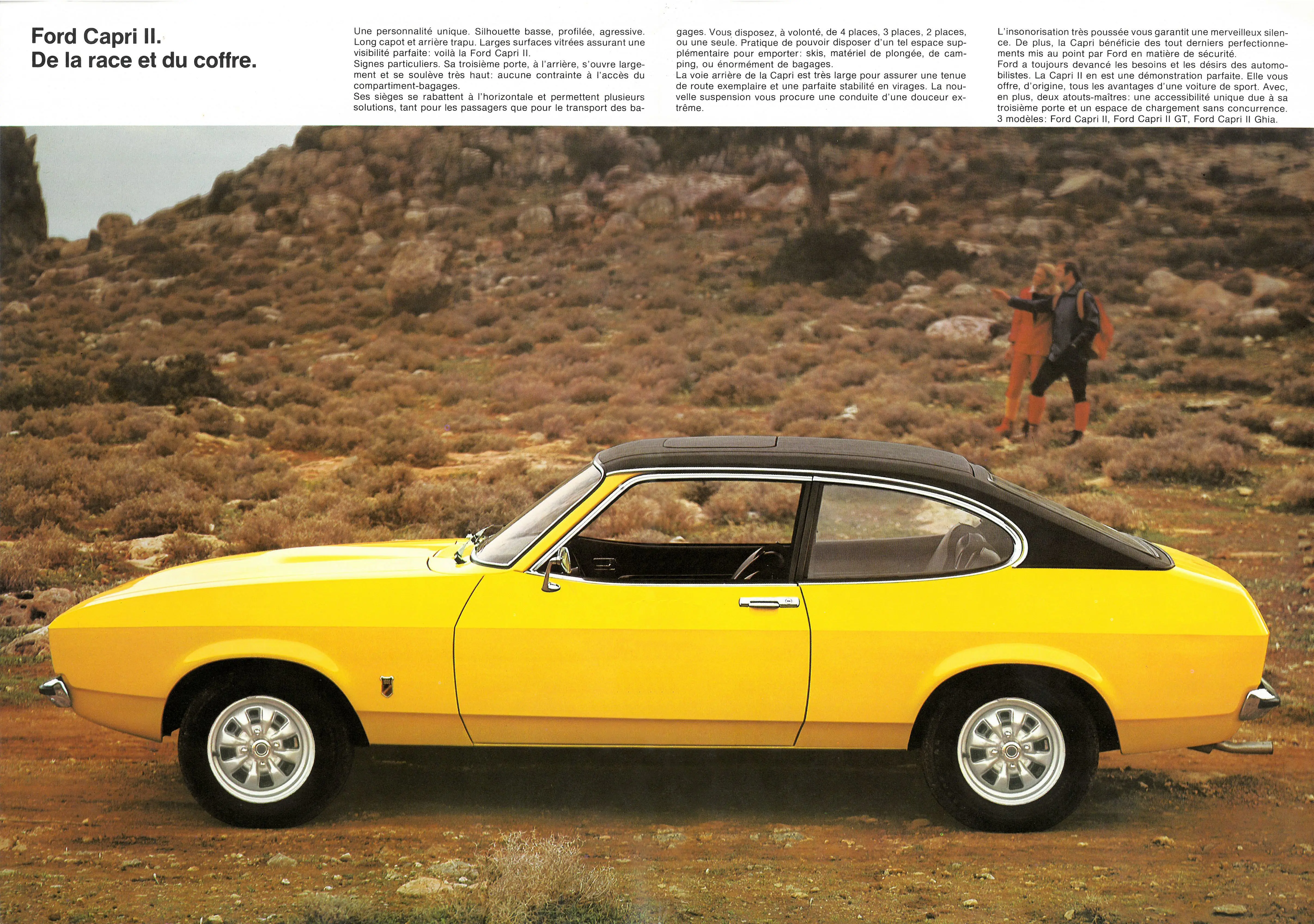The Ford Capri II at Fifty by Andrew Roberts!
05 January 2024
When Ford unveiled the Capri II on the 25th of February 1974, they faced a vast challenge – how do you improve on the original Capri? August 1973 had seen the millionth Capri Mk. I leave the production line, but a Motor report highlighted the key to the second-generation model’s image. When they tested the 1600XL version, they thought it was “not as taut and responsive as the original Capri”. However, it was “generally more refined than the old one – and a lot more versatile”.
Daniel O’Callaghan points out “Just 100,000 Mk2s were sold in 1975, less than half the Mk1’s 1973 peak sales of 233,000”. Yet, by the mid-seventies, many drivers who ordered “The Car You Always Promised Yourself” in 1969 now had families, making the Capri II the ideal vehicle. It looked more refined than its predecessor; the fake air scoops and ‘hockey stick’ lines on the side were gone. More importantly, it was Ford GB’s first hatchback.
The range commenced with the 1300L at £1,336.25, progressing to the 1600L, XL, and GT, the 2000GT, and the 3000GT for £1,931.66. Such prices made the Capri II highly competitively priced compared with its British rivals. an MGB GT was £1,748, a Sunbeam Rapier H120 was £2,072, and a Vauxhall Magnum 2.3 Coupe was £1,465. Elitists who demanded a carpeted load bay and a heated rear screen would have to specify the XL instead of the L, while the GT featured extra instruments and twin-choke Weber carburettors.

For the sporting driver/complete Medallion Man, the GT could be specified with a £63.01 ‘Sports Custom Pack’ comprising a map reading lamp, rear washer, and wiper, a push-button radio, bumper overriders, a coachline and – but of course – ‘sports’ wheels. Autocar believed the Capri II represented “a vast improvement on earlier models”. Meanwhile, Car regarded the 2000GT as attractive and practical but found the engine speed “tinny”, and they much preferred the VW Scirocco TS and the Toyota Celica ST. That said, the report did note that the Ford had the backing of a vast dealer network, and cheaper parts than its rivals, which must count for something against the hard days ahead when every pound will count like it never has before.
By the 1st of May, there was a new Ghia flagship – Ford had acquired the Turin design house Carrozzeria Ghia in 1970. As befitting a car for the social elite/regional sales director, the specification included a slide/tilt sunroof, alloy wheels, tinted glass, high-backed front seats, a vinyl roof, and the finest Rialto nylon upholstery available to humanity. Your friendly local Ford dealer would probably tell you that for £2,609, the Capri 3.0-litre Ghia was considerably cheaper than the Reliant Scimitar GTE at £3,240.
The two cars shared an ‘Essex’ V6 engine but had different images. Motor Sport grumbled the Tamworth product had “a look of quality, elegance and individuality which Henry Ford’s mass-production lines would find completely unviable to emulate”. However, most Capri Ghia owners probably did not care as they adjusted their medallions prior to heading to that happening Surbiton night spot.
The summer of 1975 saw Ford produce 2,003 examples of the John Player Special, aka the JPS. It was a clever way of promoting the new Capri 2-litre and 3-litre S, due for launch in October 1975. Some examples - perhaps 25% - of the JPS had a white paint finish. However, the most famous colour scheme was black with gold trim, reflecting John Player Special Cigarettes’ sponsorship of the Lotus Formula 1 team.
That year also saw the introduction of the new entry-level Capri 1300 – “A Capri for less than the price of most ordinary family saloons”. £1,771 gained the proud owner such decadent fittings as “hazard warning lamps” and a “black look” exterior. Anyone who wanted a split rear seat and reclining front backrests had to invest in the Capri 1300L.
In its way, the basic 1300 was as important as the Ghia, allowing the owner on a limited budget to dream of wide-open roads – even with the 1.3-litre engine’s restricted performance. After all, the Capri II’s role, as with its predecessor, was providing a combination of practicality and wish fulfilment. The 1300 owner could even, with the careful application of after-market accessories, make their Capri resemble a 3000S. Albeit at a distance, and providing they did not actually fire the engine.
October 1976 marked the end of Capri production in the UK, eighteen months before the introduction of the third-generation model. Perhaps the Capri II’s finest hour was in Brannigan, John Wayne’s only film shot in this country. The picture was shot in 1974 with a set-piece chase between a Jaguar S-Type (the regulation British villain’s car of the “70s) and a Ford PR fleet Capri 3.0 GT.
At the wheel of the Jaguar was the great Peter Brayham, who really did jump Tower Bridge, much to the wrath of the London Metropolitan Police. Doubling for Wayne in a Capri 3000 GT was the ace stunt driver Frank Henson, who recalled in his memoirs The Luck of Losing the Toss: My Stunt Career in the Movies and TV how:
They allowed us to put the bridge back up as it had been for Peter’s ‘jump’. I carefully drove the car to the top edge and then reversed it down at speed, all the time looking ahead, which isn’t easy to do, believe me. Then we moved to the other side, and I reversed up to the top edge before driving the Ford down at speed and crashing into a skip. They then filmed John Wayne kicking the door open. We used a model for the long shot of the Capri crossing the gap, and a seven-foot rostrum to film the brief shots of the Capri in the air.
In other words – Ford Capri II cinematic magic:
